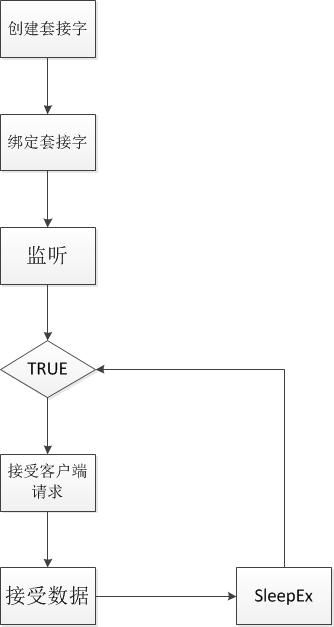【网络编程】之十一、重叠IO Overlapped IO 完成例程
完成例程是Win Sockets提供的另一种管理完成的重叠I/O方法,完成例程是一个函数,当发起重叠操作时,将该函数传递给发起操作的函数,当重叠IO操作完成时由系统调用。
下面来看一下例程必须拥有下面的函数原型:
void CALLBACK CompletionROUTINE{
IN DWORD dwError, //重叠操作的完成状态。
IN DWORD cbTransferred, //实际传输的字节数。
IN LPWSAOVERLAPPED lpOVerlapped, //初始化重叠操作的那个重叠结构
IN DWORD dwFlags //一个标志参数
};
OK ,在应用程序中使用完成例程管理重叠IO操作时,你必须给调用函数制定一个完成例程,一个WSAOVERLAPPED结构,在这里WSAOVERLAPPED的hEvent字段不会被使用,因为你使用完成例程来管理重叠操作的最终结果。
当我们的调用写成在重叠操作完成后必须为完成例程提供服务,将调用线程置为“可警告的县城等待状态”。在这种状态下,重叠IO操作完成时,完成例程也被调用。
下面来看两个函数,他们可以设置线程为一种可警告的等待状态:
WSAWatiForMultipleEvents
DWORD WSAAPI WSAWaitForMultipleEvents(
DWORD cEvents,//The number of event object handles in the array pointed to by lphEvents. WSA_MAXIMUM_WAIT_EVENTS是句柄最大值
const WSAEVENT FAR * lphEvents, //A pointer to an array of event object handles.
BOOL fWaitAll,// the wait type!TURE:当lphEvents的所有对象有信号的时候函数返回。FALSE:当任意一个事件对象有信号时函数返回
DWORD dwTimeout,//The time-out interval,秒为单位
BOOL fAlertable );//指定当系统将一个输入/输出完成例程放入队列以供执行时,函数是否返回。TRUE:函数返回并执行完成例程FALSE:函数不返回也不执行完成例程。
如果函数成功,返回值指出造成函数返回的事件对象。
如果函数失败,返回值为WSA_WAIT_FAILED。
来说一下最后一个参数,当为TRUE时,说明该函数返回时完成例程已经被执行。 如果该参数为FALSE,那么说明该函数返回时完成例程还没有执行。
通过设置TRUE,将调用线程置于可警告的等待状态,当该函数返回的时候,返回值为:WAIT_IO_COMPLETION。
在这里,我们为了使用WSAWaitForMultipleEvents,在应用程序中可以定义一个不和任何对相关联的事件对象。 然后我们用这个事件对象为参数来调用该函数。
函数返回的时候,我们要判断一下返回值是否是:WAIT_IO_COMPLETION,如果返回这个值,那么就说明这时候完成例程已经被调用了。如果不是,那么就说明发生了错误。
SleepEx
DWORD SleepEx{
DWORD dwMilliseconds,//等待时间,ms为单位, INFINITE说明函数将无限等待
BOOL bAlertable//函数的返回方式1、FALSE,在不调用超时的情况下是不返回的。2、TRUE 调用超时或者 //发生IO回调,那么就返回。
};
这里存在一个调用超时的问题,如果超时了,那么返回值就是0, 如果发生了IO完成回调,那么函数就会返回,返回值是:WAIT_IO_COMPLETION。
重叠io完成例程要求我们讲一个瓦按成例程指定给发起IO操作的函数, 当io操作完成后,完成例程就被调用。 下面来看一下开发win socket的步骤:
1、创建具有WSAOVERLAPPED标志的套接字。
2、定义完成例程。
3、调用输入或者输出函数,初始化重叠IO操作,调用函数的最后一个参数为应用从程序定义的完成例程。
4、调用WSAWaitForMultipleEvents()函数或者SleepEx()函数,使线程处于可警告的等待状态。如果调用WSAWaitForMultipleEvents()函数 我们需要一个应用程序定义的事件对象,以便该函数等待事件的发生。这两个函数的最后一个参数要设置为TRUE。
5、当发生重叠IO回调时,完成例程被调用。
下面来看一下WSAOVERLAPPED结构:
typedef struct _WSAOVERLAPPED { ULONG_PTR Internal;//os保留,指出一个和系统相关的状态 ULONG_PTR InternalHigh;//发送,接收数据的长度 union { struct { DWORD Offset;//文件的初始位置 DWORD OffsetHigh;//文件的偏移量 }; PVOID Pointer;//指向文件传送位置,do not use after initialization to zero. }; HANDLE hEvent;//指定一个IO操作完成后触发的事件 } WSAOVERLAPPED, *LPWSAOVERLAPPED;
下面来看一下WSAOVERLAPPED结构的实例:
#include <winsock2.h>
#include <ws2tcpip.h>
#include <stdio.h>
#include <stdlib.h>
// Need to link with Ws2_32.lib
#pragma comment(lib, "ws2_32.lib")
int __cdecl main()
{
//---------------------------------------------
// Declare and initialize variables
WSADATA wsaData;
WSABUF DataBuf;
WSAOVERLAPPED Overlapped;
SOCKET SendToSocket = INVALID_SOCKET;
struct sockaddr_in RecvAddr;
struct sockaddr_in LocalAddr;
int RecvAddrSize = sizeof (RecvAddr);
int LocalAddrSize = sizeof (LocalAddr);
u_short Port = 27015;
struct hostent *localHost;
char *ip;
char SendBuf[1024] = "Data buffer to send";
int BufLen = 1024;
DWORD BytesSent = 0;
DWORD Flags = 0;
int rc, err;
int retval = 0;
//---------------------------------------------
// Initialize Winsock
// Load Winsock
rc = WSAStartup(MAKEWORD(2, 2), &wsaData);
if (rc != 0) {
printf("Unable to load Winsock: %d\n", rc);
return 1;
}
// Make sure the SendOverlapped struct is zeroed out
SecureZeroMemory((PVOID)&Overlapped, sizeof(WSAOVERLAPPED));
// Create an event handle and setup the overlapped structure.
Overlapped.hEvent = WSACreateEvent();
if (Overlapped.hEvent == NULL) {
printf("WSACreateEvent failed with error: %d\n", WSAGetLastError());
WSACleanup();
return 1;
}
//---------------------------------------------
// Create a socket for sending data
SendToSocket =
WSASocket(AF_INET, SOCK_DGRAM, IPPROTO_UDP, NULL, 0,
WSA_FLAG_OVERLAPPED);
if (SendToSocket == INVALID_SOCKET) {
printf("socket failed with error: %d\n", WSAGetLastError());
WSACloseEvent(Overlapped.hEvent);
WSACleanup();
return 1;
}
//---------------------------------------------
// Set up the RecvAddr structure with the IP address of
// the receiver (in this example case "127.0.0.1")
// and the specified port number.
RecvAddr.sin_family = AF_INET;
RecvAddr.sin_port = htons(Port);
RecvAddr.sin_addr.s_addr = inet_addr("127.0.0.1");
//---------------------------------------------
// Set up the LocalAddr structure with the local IP address
// and the specified port number.
localHost = gethostbyname("");//返回本地主机的标准主机名
ip = inet_ntoa(*(struct in_addr *) *localHost->h_addr_list);
LocalAddr.sin_family = AF_INET;
LocalAddr.sin_addr.s_addr = inet_addr(ip);
LocalAddr.sin_port = htons(Port);
//---------------------------------------------
// Bind the sending socket to the LocalAddr structure
// that has the internet address family, local IP address
// and specified port number.
rc = bind(SendToSocket, (struct sockaddr *) &LocalAddr, LocalAddrSize);
if (rc == SOCKET_ERROR) {
printf("bind failed with error: %d\n", WSAGetLastError());
WSACloseEvent(Overlapped.hEvent);
closesocket(SendToSocket);
WSACleanup();
return 1;
}
//---------------------------------------------
// Send a datagram to the receiver
printf("Sending a datagram...\n");
DataBuf.len = BufLen;
DataBuf.buf = SendBuf;
rc = WSASendTo(SendToSocket, &DataBuf, 1,
&BytesSent, Flags, (SOCKADDR *) & RecvAddr,
RecvAddrSize, &Overlapped, NULL);
if ((rc == SOCKET_ERROR) && (WSA_IO_PENDING != (err = WSAGetLastError()))) {
printf("WSASendTo failed with error: %d\n", err);
WSACloseEvent(Overlapped.hEvent);
closesocket(SendToSocket);
WSACleanup();
return 1;
}
rc = WSAWaitForMultipleEvents(1, &Overlapped.hEvent, TRUE, INFINITE, TRUE);
if (rc == WSA_WAIT_FAILED) {
printf("WSAWaitForMultipleEvents failed with error: %d\n",
WSAGetLastError());
retval = 1;
}
rc = WSAGetOverlappedResult(SendToSocket, &Overlapped, &BytesSent,
FALSE, &Flags);//返回指定套接字口上一个重叠操作结果。
if (rc == FALSE) {
printf("WSASendTo failed with error: %d\n", WSAGetLastError());
retval = 1;
}
//---------------------------------------------
// When the application is finished sending, close the socket.
printf("Finished sending. Closing socket.\n");
WSACloseEvent(Overlapped.hEvent);
closesocket(SendToSocket);
printf("Exiting.\n");
//---------------------------------------------
// Clean up and quit.
WSACleanup();
return (retval);
}
WSAOVERLAPPED 和 WSAGetOverlappedResult在上一节中都给出过: http://blog.csdn.net/jofranks/article/details/7895316
----2012/9/20
----jofranks 于南昌
